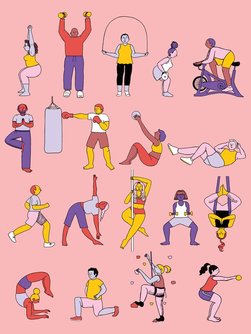 According to a piece on NPR’s morning edition called Words Matter When Talking About Pain with Your Doctor, physicians are moving away from using the simple zero to ten pain scale to gauge a patient’s current state of pain. Doctors have found that routinely asking patients to use words to describe both pain levels and their challenges allows for more context and patient engagement, leading to more effective treatment plans and better results. I believe the same is true when working with your Pilates or movement instructor. That’s why I ask my clients so many questions before, during, and after our sessions! Your answers help me make programming decisions on what today’s lesson should entail and the best approach. And, just as importantly, my Q & A helps to increase your “attention muscle.” Your ability to notice and express what you feel and our subsequent conversation can help you to discern and differentiate those sensations. These important body-awareness skills empower you to work with your body, instead of against it.
0 Comments
 “Why do I feel tighter following my yoga class, but never after my pilates class?” Twice in the past month I’ve been asked this question! The question came from two clients who had many similarities: experienced female practitioners of yoga and pilates with average range of motion yet often report “feeling tight.” I haven’t witnessed these clients in their yoga classes, nor do I know anything of the yoga teacher’s style or goals for their class. All I can offer is my expert guess of what is happening for these two ladies. When I teach Pilates or Restorative Exercise, the focus is on slow and controlled dynamic movements at your end ranges, with special attention on form and joint position. To some this feels more like a slow strength class than a stretch class, but students are pleasantly surprised to see their end ranges increase as the class goes on. Because students use their own strength and control to find their end range, students are safeguarded from overstretching. When doing passive stretching, like when you use your arm, a yoga strap, or gravity to cause a stretching sensation, it’s easier to inadvertently overstretch. At its worst, overstretching can cause a muscle strain or tear. In lesser amounts, overstretching can cause a rebound effect, making your body feel tighter and/or weaker than it did before. That’s what I think was happening to these ladies after their yoga classes. To avoid overstretching in a group class, I recommend decreasing the amount of stretch sensation when performing passive stretches. So on a scale from 0 to 10, keep the sensation in the 5 or 6 range. The other attributes of yoga - focusing on your breath while performing gentle movements in a calming atmosphere for an hour can collectively regulate your nervous system for positive results…..including relieving your body from the feeling of tightness…. without the rebound effect the following day.  I just read an article by Gabriel Winant of The New Republic called Mind Control - Barbara Ehrenreich’s radical critique of wellness and self-improvement. I love the idea mentioned at the end about manifesting social solidarity as the ultimate self-care. But in order to participate and contribute to the world in a positive manner, self-care for the individual is needed. Ms Ehrenreich’s critique of the "beat your body into submission" gym culture is spot on, but shouldn't be confused with more humble journeys of wellness, such as cultivating body awareness and the ability to self-regulate. Your mind and body are in a (hopefully) long term relationship that needs communication, thoughtfulness and mutual respect. To thrive, this relationship will also need varying amounts of assertiveness, flexibility, compromise. Cultivating your body awareness and learning to self-regulate what your body needs on a daily basis helps you manage this ever evolving relationship. And, just like humans sometimes need a little help navigating relationships with family and spouses, guidance for cultivating your body/mind relationship is sometimes needed too. Far from being selfish, I believe finding the solidarity within is a good first step to manifesting universal solidarity.  New to PIVOT Pilates + Restorative Exercise? Here are a few of our expert tips to help you get the most out of your sessions! 1) Wear clothing that's comfortable but also allows you and your instructor to see the outline of your body. 2) Wear clothing that is also comfortable in different positions, such as bending down or lying on your back with your legs propped up. 3) Wear long hair off your shoulders so your instructor can clearly see your neck and upper back. Soft elastics or clips are recommended as barrettes or combs can be uncomfortable while lying on your back. 4) Go barefoot if you can. All sessions are done without shoes, but going without socks will give you more traction and more spatial awareness. 5) Ditch the chewing gum. Fresh breath is appreciated, but chewing gum can affect your breathing mechanics and how your core muscles work. 6) Communicate with your instructor. Your instructor will ask you questions to help facilitate learning and make programming decisions, especially in the beginning stages. 7) Pay attention to how your body feels for the rest of the day and the following morning, and let your instructor know. This will help guide your next session! 8) Pat yourself on the back for making an investment in yourself! |
 RSS Feed
RSS Feed